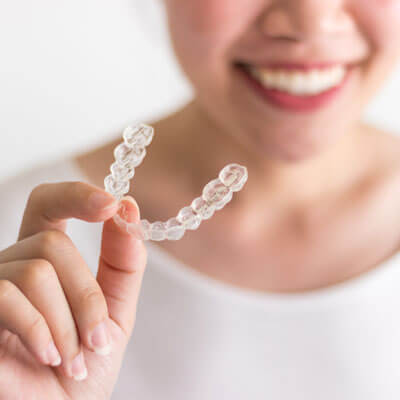Occlusal Splint Therapy at St. Leonards Square Dental Care
 The way your teeth bite together forms a specific relationship that we call an occlusion. But occasionally teeth may clench together, grind or meet inappropriately in a way that leads to complications such as
The way your teeth bite together forms a specific relationship that we call an occlusion. But occasionally teeth may clench together, grind or meet inappropriately in a way that leads to complications such as
- TMJ disorder
- Chipped enamel
- Broken dental work
- Headaches
- Gum recession
- Premature wear
Preventing Pain and Tooth Wear
When you wear an occlusal splint, the device naturally relaxes your muscles and TMJ to ease the tension between your upper and lower teeth. But if you do clench and grind (such as when you’re sleeping) it will wear out the acrylic rather than your tooth enamel. Fortunately, splints and related nightguards are easy to replace.
If you’re waking up in the morning with sore teeth or jaw muscles, you’re likely bruxing during your sleep. Since night time clenching and grinding is a subconscious habit, an occlusal splint is really the only option to safeguard your teeth.
Ideally, your mouth should rest with your lips touching but your teeth slightly apart. During the day if you’re feeling stressed or concentrating on something, you might find that you’re clenching your teeth together. Sometimes people can consciously work on eliminating this habit but the rest of us may need a bite splint to help.
Nightguards are occlusal splints designed to wear while you’re sleeping. Since bite splints come in various designs, some are easier to wear during the day than others. But a night splint will typically cover your entire arch more like a protective mouthguard.
You can tell your night guard is working if pain is diminished or you see that you’re grinding through the acrylic. Remember, it’s better to replace a temporary dental device than it is to repair your natural smile!
Since bite splints are worn for several hours at a time, they can attract buildup just like your teeth. It’s important to clean them daily to prevent bacterial accumulation, oral infections or bad breath.
Plan to clean your occlusal splint the same way you would a retainer, denture or clear alignment tray. Use lukewarm tap water and an effervescent cleansing tab to soak it at least a few hours, then brush it clean. Be sure to rinse away any leftover residue. Take care not to use hot water, as it may cause the appliance to warp.
People clench and grind their teeth for a variety of reasons. Stressful lifestyles and obstructive sleep apnoea are just a couple of examples. These underlying factors can also pose an overall health risk. A holistic approach to managing bruxism doesn’t just involve occlusal splint therapy but could also include lifestyle changes, meditation, exercise or medication.
Request Your Custom Appliance
For occlusal splint therapy St Leonards, contact us today!
CONTACT US
Any invasive or surgical procedure may carry risks. Before moving forward, it is recommended that you seek a second opinion from an appropriately licensed medical professional.


